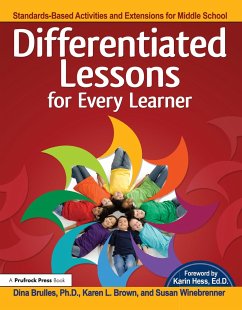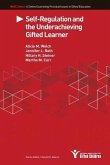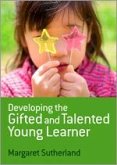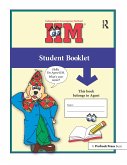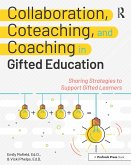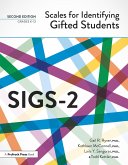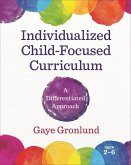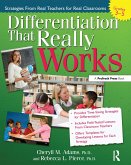Dina Brulles, Karen L Brown, Susan Winebrenner
Differentiated Lessons for Every Learner
Standards-Based Activities and Extensions for Middle School (Grades 6-8)
Dina Brulles, Karen L Brown, Susan Winebrenner
Differentiated Lessons for Every Learner
Standards-Based Activities and Extensions for Middle School (Grades 6-8)
- Broschiertes Buch
- Merkliste
- Auf die Merkliste
- Bewerten Bewerten
- Teilen
- Produkt teilen
- Produkterinnerung
- Produkterinnerung
Differentiated Lessons for Every Learner supports middle school teachers in teaching all students, including those with high ability. The book contains lessons in each content area with learning activities that align to the national content standards, embed ELA Common Core Standards, and correlate to DOK levels.
Andere Kunden interessierten sich auch für
![Self-Regulation and the Underachieving Gifted Learner Self-Regulation and the Underachieving Gifted Learner]() Alicia M. WelchSelf-Regulation and the Underachieving Gifted Learner18,99 €
Alicia M. WelchSelf-Regulation and the Underachieving Gifted Learner18,99 €![Developing the Gifted and Talented Young Learner Developing the Gifted and Talented Young Learner]() Margaret SutherlandDeveloping the Gifted and Talented Young Learner63,99 €
Margaret SutherlandDeveloping the Gifted and Talented Young Learner63,99 €![IIM IIM]() Cindy NottageIIM10,99 €
Cindy NottageIIM10,99 €![Collaboration, Coteaching, and Coaching in Gifted Education Collaboration, Coteaching, and Coaching in Gifted Education]() Emily MofieldCollaboration, Coteaching, and Coaching in Gifted Education45,99 €
Emily MofieldCollaboration, Coteaching, and Coaching in Gifted Education45,99 €![Scales for Identifying Gifted Students (Sigs-2) Scales for Identifying Gifted Students (Sigs-2)]() Gail R RyserScales for Identifying Gifted Students (Sigs-2)84,99 €
Gail R RyserScales for Identifying Gifted Students (Sigs-2)84,99 €![Individualized Child-Focused Curriculum: A Differentiated Approach Individualized Child-Focused Curriculum: A Differentiated Approach]() Gaye GronlundIndividualized Child-Focused Curriculum: A Differentiated Approach42,99 €
Gaye GronlundIndividualized Child-Focused Curriculum: A Differentiated Approach42,99 €![Differentiation That Really Works Differentiation That Really Works]() Cheryll M AdamsDifferentiation That Really Works23,99 €
Cheryll M AdamsDifferentiation That Really Works23,99 €-
-
-
Differentiated Lessons for Every Learner supports middle school teachers in teaching all students, including those with high ability. The book contains lessons in each content area with learning activities that align to the national content standards, embed ELA Common Core Standards, and correlate to DOK levels.
Hinweis: Dieser Artikel kann nur an eine deutsche Lieferadresse ausgeliefert werden.
Hinweis: Dieser Artikel kann nur an eine deutsche Lieferadresse ausgeliefert werden.
Produktdetails
- Produktdetails
- Verlag: Taylor & Francis Ltd (Sales)
- Seitenzahl: 270
- Erscheinungstermin: 15. März 2016
- Englisch
- Abmessung: 277mm x 213mm x 18mm
- Gewicht: 635g
- ISBN-13: 9781618215420
- ISBN-10: 1618215426
- Artikelnr.: 43719800
- Herstellerkennzeichnung
- Libri GmbH
- Europaallee 1
- 36244 Bad Hersfeld
- gpsr@libri.de
- Verlag: Taylor & Francis Ltd (Sales)
- Seitenzahl: 270
- Erscheinungstermin: 15. März 2016
- Englisch
- Abmessung: 277mm x 213mm x 18mm
- Gewicht: 635g
- ISBN-13: 9781618215420
- ISBN-10: 1618215426
- Artikelnr.: 43719800
- Herstellerkennzeichnung
- Libri GmbH
- Europaallee 1
- 36244 Bad Hersfeld
- gpsr@libri.de
Susan Winebrenner is a full-time consultant in staff development. She presents workshops and seminars nationally and internationally, helping educators translate educational research into classroom practice.
Dedication Acknowledgments Foreword Introduction Chapter 1: Using the
Extension Lessons Chapter 2: English Language Arts Extension Lesson
Introduction Language Arts and Elements of Language Lesson 2.1: American
Studies Lesson 2.2: Author Studies Lesson 2.3: Cause and Effect Lesson 2.4:
Theme Lesson 2.5: Vocabulary in Text Lesson 2.6: Persuasive Writing Poetry,
Literature, and Informational Text Lesson 2.7: Poetry Elements Lesson 2.8:
Poetic Connections Lesson 2.9: Writing Short Stories Lesson 2.10: Short
Story Elements Lesson 2.11: Response to Literature Lesson 2.12:
Shakespeare's Characters Lesson 2.13: Biography Novel Studies Lesson 2.14:
Novel Studies Lesson 2.15: Novel Study Exploratory Activities Lesson 2.16:
Survival Novels Lesson 2.17: Chasing Vermeer Lesson 2.18: From the Mixed-Up
Files of Mrs. Basil E. Frankweiler Lesson 2.19: The Pushcart War Lesson
2.20: Walk Two Moons Lesson 2.21: The Phantom Tollbooth Chapter 3: Social
Studies/History Extension Lessons Introduction World History Lesson 3.1:
Ancient Civilizations Lesson 3.2: Middle Ages Lesson 3.3: Feudalism and the
Middle Ages Lesson 3.4: World War I and World War II Lesson 3.5: The
Holocaust United States History Lesson 3.6: Explorers of the New World
Lesson 3.7: Exploration and Explorers Lesson 3.8: Puritan Colonization of
the New World Lesson 3.9: Colonies in the New World Lesson 3.10: Challenges
in the New World Lesson 3.11: John Smith and the 13 Colonies Lesson 3.12:
American Revolution and the Stamp Act Lesson 3.13: American Revolution:
Causal Factors Lesson 3.14: Civil War Lesson 3.15: American Wars Social
Studies Lesson 3.16: Study of a Decade Lesson 3.17: World Cultures Lesson
3.18: Teens in Other Cultures Lesson 3.19: Discovery and Colonization
Lesson 3.20: Iditarod Lesson 3.21: Native American Life Lesson 3.22:
Economics Lesson 3.23: Government Chapter 4: Mathematics Extension Lessons
Introduction Numbers, Operations, and Problem Solving Lesson 4.1:
Computational Thinking Lesson 4.2: Algebraic Thinking Lesson 4.3: Fractions
Lesson 4.4: Fermi Questions Lesson 4.5: Multiple Intelligences Problem
Solving Lesson 4.6: Modeling With Mathematics Lesson 4.7: Ratios and
Proportions Geometry Lesson 4.8: Geometry Lesson 4.9: Geometry Problem
Solving Lesson 4.10: Coordinate Plane Lesson 4.11: Polygons and Angles
Lesson 4.12: Geometric Thinking in Sports Math Studies Lesson 4.13: Math
Studies Lesson 4.14: Famous Mathematicians Lesson 4.15: Science,
Technology, Engineering, and Math (STE Chapter 5: Science Extension Lessons
Introduction Biology Lesson 5.1: Cells and Microorganisms Lesson 5.2: Cell
Structure Lesson 5.3: Cells Lesson 5.4: Human Body Lesson 5.5: Life
Sciences Chemistry Lesson 5.6: Acids and Bases Lesson 5.7: Periodic Table
Lesson 5.8: Stoichiometry Lesson 5.9: Heat Physics Lesson 5.10: Force and
Motion Lesson 5.11: Light and Sound Lesson 5.12: Work and Energy Lesson
5.13: Energy and Forces Earth Science Lesson 5.14: Air Pollution Lesson
5.15: Atmosphere Lesson 5.16: Diversity in Environments Lesson 5.17: Earth
Science Lesson 5.18: Ecosystems Lesson 5.19: Environment Lesson 5.20:
Volcanoes Lesson 5.21: Water Pollution Lesson 5.22: Water Quality and
Ecology Lesson 5.23: Weathering and Erosion Lesson 5.24: Wildlife
Conservation Lesson 5.25: Technology in the Sciences Chapter 6: Special
Areas and Electives Extension Lessons Introduction Music Lesson 6.1:
Instructional Music Lesson 6.2: Music Styles Lesson 6.3: Study of Music
Lesson 6.4: Vocal Music Lesson 6.5: Band Lesson 6.6: Instrumental Music:
Digital Connections Lesson 6.7: Instrumental Music Lesson 6.8: Orchestra
Arts and Theatre Lesson 6.9: Art Fantasy Figures Lesson 6.10: Influences in
Art Lesson 6.11: Schools of Art Lesson 6.12: Study of Art Lesson 6.13:
Theatre Arts Lesson 6.14: Theatre Arts: Technical Theatre Lesson 6.15:
Dance Physical Education Lesson 6.16: Fitness Lesson 6.17: Physical
Education Foreign Language Lesson 6.18: Creating a Foreign Language
Broadcast Lesson 6.19: World Language Conclusion References Appendix:
Rubric and Forms About the Authors Common Core State Standards
Extension Lessons Chapter 2: English Language Arts Extension Lesson
Introduction Language Arts and Elements of Language Lesson 2.1: American
Studies Lesson 2.2: Author Studies Lesson 2.3: Cause and Effect Lesson 2.4:
Theme Lesson 2.5: Vocabulary in Text Lesson 2.6: Persuasive Writing Poetry,
Literature, and Informational Text Lesson 2.7: Poetry Elements Lesson 2.8:
Poetic Connections Lesson 2.9: Writing Short Stories Lesson 2.10: Short
Story Elements Lesson 2.11: Response to Literature Lesson 2.12:
Shakespeare's Characters Lesson 2.13: Biography Novel Studies Lesson 2.14:
Novel Studies Lesson 2.15: Novel Study Exploratory Activities Lesson 2.16:
Survival Novels Lesson 2.17: Chasing Vermeer Lesson 2.18: From the Mixed-Up
Files of Mrs. Basil E. Frankweiler Lesson 2.19: The Pushcart War Lesson
2.20: Walk Two Moons Lesson 2.21: The Phantom Tollbooth Chapter 3: Social
Studies/History Extension Lessons Introduction World History Lesson 3.1:
Ancient Civilizations Lesson 3.2: Middle Ages Lesson 3.3: Feudalism and the
Middle Ages Lesson 3.4: World War I and World War II Lesson 3.5: The
Holocaust United States History Lesson 3.6: Explorers of the New World
Lesson 3.7: Exploration and Explorers Lesson 3.8: Puritan Colonization of
the New World Lesson 3.9: Colonies in the New World Lesson 3.10: Challenges
in the New World Lesson 3.11: John Smith and the 13 Colonies Lesson 3.12:
American Revolution and the Stamp Act Lesson 3.13: American Revolution:
Causal Factors Lesson 3.14: Civil War Lesson 3.15: American Wars Social
Studies Lesson 3.16: Study of a Decade Lesson 3.17: World Cultures Lesson
3.18: Teens in Other Cultures Lesson 3.19: Discovery and Colonization
Lesson 3.20: Iditarod Lesson 3.21: Native American Life Lesson 3.22:
Economics Lesson 3.23: Government Chapter 4: Mathematics Extension Lessons
Introduction Numbers, Operations, and Problem Solving Lesson 4.1:
Computational Thinking Lesson 4.2: Algebraic Thinking Lesson 4.3: Fractions
Lesson 4.4: Fermi Questions Lesson 4.5: Multiple Intelligences Problem
Solving Lesson 4.6: Modeling With Mathematics Lesson 4.7: Ratios and
Proportions Geometry Lesson 4.8: Geometry Lesson 4.9: Geometry Problem
Solving Lesson 4.10: Coordinate Plane Lesson 4.11: Polygons and Angles
Lesson 4.12: Geometric Thinking in Sports Math Studies Lesson 4.13: Math
Studies Lesson 4.14: Famous Mathematicians Lesson 4.15: Science,
Technology, Engineering, and Math (STE Chapter 5: Science Extension Lessons
Introduction Biology Lesson 5.1: Cells and Microorganisms Lesson 5.2: Cell
Structure Lesson 5.3: Cells Lesson 5.4: Human Body Lesson 5.5: Life
Sciences Chemistry Lesson 5.6: Acids and Bases Lesson 5.7: Periodic Table
Lesson 5.8: Stoichiometry Lesson 5.9: Heat Physics Lesson 5.10: Force and
Motion Lesson 5.11: Light and Sound Lesson 5.12: Work and Energy Lesson
5.13: Energy and Forces Earth Science Lesson 5.14: Air Pollution Lesson
5.15: Atmosphere Lesson 5.16: Diversity in Environments Lesson 5.17: Earth
Science Lesson 5.18: Ecosystems Lesson 5.19: Environment Lesson 5.20:
Volcanoes Lesson 5.21: Water Pollution Lesson 5.22: Water Quality and
Ecology Lesson 5.23: Weathering and Erosion Lesson 5.24: Wildlife
Conservation Lesson 5.25: Technology in the Sciences Chapter 6: Special
Areas and Electives Extension Lessons Introduction Music Lesson 6.1:
Instructional Music Lesson 6.2: Music Styles Lesson 6.3: Study of Music
Lesson 6.4: Vocal Music Lesson 6.5: Band Lesson 6.6: Instrumental Music:
Digital Connections Lesson 6.7: Instrumental Music Lesson 6.8: Orchestra
Arts and Theatre Lesson 6.9: Art Fantasy Figures Lesson 6.10: Influences in
Art Lesson 6.11: Schools of Art Lesson 6.12: Study of Art Lesson 6.13:
Theatre Arts Lesson 6.14: Theatre Arts: Technical Theatre Lesson 6.15:
Dance Physical Education Lesson 6.16: Fitness Lesson 6.17: Physical
Education Foreign Language Lesson 6.18: Creating a Foreign Language
Broadcast Lesson 6.19: World Language Conclusion References Appendix:
Rubric and Forms About the Authors Common Core State Standards
Dedication Acknowledgments Foreword Introduction Chapter 1: Using the
Extension Lessons Chapter 2: English Language Arts Extension Lesson
Introduction Language Arts and Elements of Language Lesson 2.1: American
Studies Lesson 2.2: Author Studies Lesson 2.3: Cause and Effect Lesson 2.4:
Theme Lesson 2.5: Vocabulary in Text Lesson 2.6: Persuasive Writing Poetry,
Literature, and Informational Text Lesson 2.7: Poetry Elements Lesson 2.8:
Poetic Connections Lesson 2.9: Writing Short Stories Lesson 2.10: Short
Story Elements Lesson 2.11: Response to Literature Lesson 2.12:
Shakespeare's Characters Lesson 2.13: Biography Novel Studies Lesson 2.14:
Novel Studies Lesson 2.15: Novel Study Exploratory Activities Lesson 2.16:
Survival Novels Lesson 2.17: Chasing Vermeer Lesson 2.18: From the Mixed-Up
Files of Mrs. Basil E. Frankweiler Lesson 2.19: The Pushcart War Lesson
2.20: Walk Two Moons Lesson 2.21: The Phantom Tollbooth Chapter 3: Social
Studies/History Extension Lessons Introduction World History Lesson 3.1:
Ancient Civilizations Lesson 3.2: Middle Ages Lesson 3.3: Feudalism and the
Middle Ages Lesson 3.4: World War I and World War II Lesson 3.5: The
Holocaust United States History Lesson 3.6: Explorers of the New World
Lesson 3.7: Exploration and Explorers Lesson 3.8: Puritan Colonization of
the New World Lesson 3.9: Colonies in the New World Lesson 3.10: Challenges
in the New World Lesson 3.11: John Smith and the 13 Colonies Lesson 3.12:
American Revolution and the Stamp Act Lesson 3.13: American Revolution:
Causal Factors Lesson 3.14: Civil War Lesson 3.15: American Wars Social
Studies Lesson 3.16: Study of a Decade Lesson 3.17: World Cultures Lesson
3.18: Teens in Other Cultures Lesson 3.19: Discovery and Colonization
Lesson 3.20: Iditarod Lesson 3.21: Native American Life Lesson 3.22:
Economics Lesson 3.23: Government Chapter 4: Mathematics Extension Lessons
Introduction Numbers, Operations, and Problem Solving Lesson 4.1:
Computational Thinking Lesson 4.2: Algebraic Thinking Lesson 4.3: Fractions
Lesson 4.4: Fermi Questions Lesson 4.5: Multiple Intelligences Problem
Solving Lesson 4.6: Modeling With Mathematics Lesson 4.7: Ratios and
Proportions Geometry Lesson 4.8: Geometry Lesson 4.9: Geometry Problem
Solving Lesson 4.10: Coordinate Plane Lesson 4.11: Polygons and Angles
Lesson 4.12: Geometric Thinking in Sports Math Studies Lesson 4.13: Math
Studies Lesson 4.14: Famous Mathematicians Lesson 4.15: Science,
Technology, Engineering, and Math (STE Chapter 5: Science Extension Lessons
Introduction Biology Lesson 5.1: Cells and Microorganisms Lesson 5.2: Cell
Structure Lesson 5.3: Cells Lesson 5.4: Human Body Lesson 5.5: Life
Sciences Chemistry Lesson 5.6: Acids and Bases Lesson 5.7: Periodic Table
Lesson 5.8: Stoichiometry Lesson 5.9: Heat Physics Lesson 5.10: Force and
Motion Lesson 5.11: Light and Sound Lesson 5.12: Work and Energy Lesson
5.13: Energy and Forces Earth Science Lesson 5.14: Air Pollution Lesson
5.15: Atmosphere Lesson 5.16: Diversity in Environments Lesson 5.17: Earth
Science Lesson 5.18: Ecosystems Lesson 5.19: Environment Lesson 5.20:
Volcanoes Lesson 5.21: Water Pollution Lesson 5.22: Water Quality and
Ecology Lesson 5.23: Weathering and Erosion Lesson 5.24: Wildlife
Conservation Lesson 5.25: Technology in the Sciences Chapter 6: Special
Areas and Electives Extension Lessons Introduction Music Lesson 6.1:
Instructional Music Lesson 6.2: Music Styles Lesson 6.3: Study of Music
Lesson 6.4: Vocal Music Lesson 6.5: Band Lesson 6.6: Instrumental Music:
Digital Connections Lesson 6.7: Instrumental Music Lesson 6.8: Orchestra
Arts and Theatre Lesson 6.9: Art Fantasy Figures Lesson 6.10: Influences in
Art Lesson 6.11: Schools of Art Lesson 6.12: Study of Art Lesson 6.13:
Theatre Arts Lesson 6.14: Theatre Arts: Technical Theatre Lesson 6.15:
Dance Physical Education Lesson 6.16: Fitness Lesson 6.17: Physical
Education Foreign Language Lesson 6.18: Creating a Foreign Language
Broadcast Lesson 6.19: World Language Conclusion References Appendix:
Rubric and Forms About the Authors Common Core State Standards
Extension Lessons Chapter 2: English Language Arts Extension Lesson
Introduction Language Arts and Elements of Language Lesson 2.1: American
Studies Lesson 2.2: Author Studies Lesson 2.3: Cause and Effect Lesson 2.4:
Theme Lesson 2.5: Vocabulary in Text Lesson 2.6: Persuasive Writing Poetry,
Literature, and Informational Text Lesson 2.7: Poetry Elements Lesson 2.8:
Poetic Connections Lesson 2.9: Writing Short Stories Lesson 2.10: Short
Story Elements Lesson 2.11: Response to Literature Lesson 2.12:
Shakespeare's Characters Lesson 2.13: Biography Novel Studies Lesson 2.14:
Novel Studies Lesson 2.15: Novel Study Exploratory Activities Lesson 2.16:
Survival Novels Lesson 2.17: Chasing Vermeer Lesson 2.18: From the Mixed-Up
Files of Mrs. Basil E. Frankweiler Lesson 2.19: The Pushcart War Lesson
2.20: Walk Two Moons Lesson 2.21: The Phantom Tollbooth Chapter 3: Social
Studies/History Extension Lessons Introduction World History Lesson 3.1:
Ancient Civilizations Lesson 3.2: Middle Ages Lesson 3.3: Feudalism and the
Middle Ages Lesson 3.4: World War I and World War II Lesson 3.5: The
Holocaust United States History Lesson 3.6: Explorers of the New World
Lesson 3.7: Exploration and Explorers Lesson 3.8: Puritan Colonization of
the New World Lesson 3.9: Colonies in the New World Lesson 3.10: Challenges
in the New World Lesson 3.11: John Smith and the 13 Colonies Lesson 3.12:
American Revolution and the Stamp Act Lesson 3.13: American Revolution:
Causal Factors Lesson 3.14: Civil War Lesson 3.15: American Wars Social
Studies Lesson 3.16: Study of a Decade Lesson 3.17: World Cultures Lesson
3.18: Teens in Other Cultures Lesson 3.19: Discovery and Colonization
Lesson 3.20: Iditarod Lesson 3.21: Native American Life Lesson 3.22:
Economics Lesson 3.23: Government Chapter 4: Mathematics Extension Lessons
Introduction Numbers, Operations, and Problem Solving Lesson 4.1:
Computational Thinking Lesson 4.2: Algebraic Thinking Lesson 4.3: Fractions
Lesson 4.4: Fermi Questions Lesson 4.5: Multiple Intelligences Problem
Solving Lesson 4.6: Modeling With Mathematics Lesson 4.7: Ratios and
Proportions Geometry Lesson 4.8: Geometry Lesson 4.9: Geometry Problem
Solving Lesson 4.10: Coordinate Plane Lesson 4.11: Polygons and Angles
Lesson 4.12: Geometric Thinking in Sports Math Studies Lesson 4.13: Math
Studies Lesson 4.14: Famous Mathematicians Lesson 4.15: Science,
Technology, Engineering, and Math (STE Chapter 5: Science Extension Lessons
Introduction Biology Lesson 5.1: Cells and Microorganisms Lesson 5.2: Cell
Structure Lesson 5.3: Cells Lesson 5.4: Human Body Lesson 5.5: Life
Sciences Chemistry Lesson 5.6: Acids and Bases Lesson 5.7: Periodic Table
Lesson 5.8: Stoichiometry Lesson 5.9: Heat Physics Lesson 5.10: Force and
Motion Lesson 5.11: Light and Sound Lesson 5.12: Work and Energy Lesson
5.13: Energy and Forces Earth Science Lesson 5.14: Air Pollution Lesson
5.15: Atmosphere Lesson 5.16: Diversity in Environments Lesson 5.17: Earth
Science Lesson 5.18: Ecosystems Lesson 5.19: Environment Lesson 5.20:
Volcanoes Lesson 5.21: Water Pollution Lesson 5.22: Water Quality and
Ecology Lesson 5.23: Weathering and Erosion Lesson 5.24: Wildlife
Conservation Lesson 5.25: Technology in the Sciences Chapter 6: Special
Areas and Electives Extension Lessons Introduction Music Lesson 6.1:
Instructional Music Lesson 6.2: Music Styles Lesson 6.3: Study of Music
Lesson 6.4: Vocal Music Lesson 6.5: Band Lesson 6.6: Instrumental Music:
Digital Connections Lesson 6.7: Instrumental Music Lesson 6.8: Orchestra
Arts and Theatre Lesson 6.9: Art Fantasy Figures Lesson 6.10: Influences in
Art Lesson 6.11: Schools of Art Lesson 6.12: Study of Art Lesson 6.13:
Theatre Arts Lesson 6.14: Theatre Arts: Technical Theatre Lesson 6.15:
Dance Physical Education Lesson 6.16: Fitness Lesson 6.17: Physical
Education Foreign Language Lesson 6.18: Creating a Foreign Language
Broadcast Lesson 6.19: World Language Conclusion References Appendix:
Rubric and Forms About the Authors Common Core State Standards

